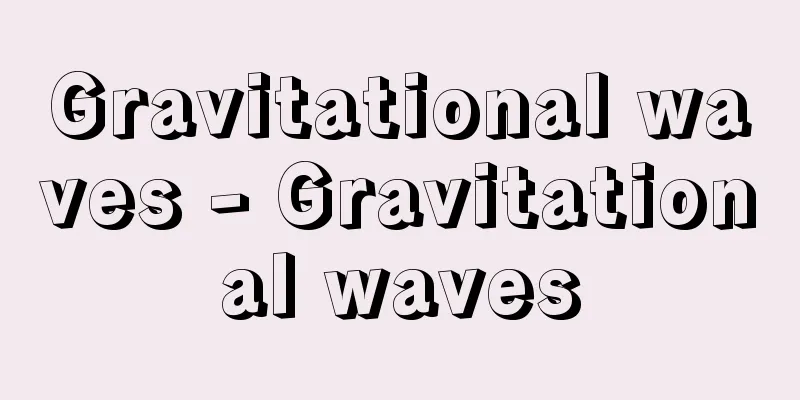Gravitational waves - Gravitational waves

|
This phenomenon occurs when the movement of a mass object causes gravity to distort the surrounding space-time (time and space), causing waves to propagate through space at the speed of light. It is also known as "ripples in space-time." Jewish theoretical physicist Albert Einstein predicted their existence in a paper on the theory of general relativity published in 1916. In 1979, American astrophysicists Joseph Taylor and Russell Hulse indirectly proved the existence of gravitational waves through their observations of binary neutron stars. Taylor and Hulse were awarded the Nobel Prize in 1993 for this achievement. Theoretically, any object with mass distorts the space-time around it, but the distortion is extremely weak. Even gravitational waves, which have been directly observed, and are generated by the merger of very heavy celestial bodies such as black holes and neutron stars, and supernova explosions, have only an effect of changing the distance between the Earth and the Sun (about 150 million kilometers) by the amount of one hydrogen atom. Since they have not been directly observed for nearly 100 years since the prediction of the general theory of relativity, they have been called "Einstein's last homework," and physicists around the world have been aiming to observe them for the first time. If observed, they will reaffirm the correctness of the general theory of relativity and lead to a new field of gravitational wave astronomy that will elucidate celestial phenomena that cannot be observed with light or radio waves. In particular, gravitational waves generated at the birth of the universe are called primordial gravitational waves, and if observed, they are thought to provide evidence for the inflation theory, which states that the universe was born from an explosive expansion. On February 12, 2016, LIGO, an international research team of over 1,000 people from 15 countries, mainly from the US, including Massachusetts Institute of Technology and California Institute of Technology, announced that they had succeeded in directly observing gravitational waves from space. LIGO used a gravitational wave detection device consisting of tubes measuring 4 kilometers on a side arranged in an L-shape, which emitted laser light in two directions simultaneously, reflecting it off a mirror 4 kilometers away, and detecting the distortion of space-time from the deviation in the reflected light that was received. In Japan, Takaaki Kajita, director of the Institute for Cosmic Ray Research at the University of Tokyo, who was awarded the Nobel Prize in Physics in 2015, and his team aimed to make the world's first direct observation of gravitational waves using the large cryogenic gravitational wave telescope KAGRA (Hida City, Gifu Prefecture). To understand the origin of the observed gravitational waves, it is necessary to observe them at multiple locations, and facilities around the world, including KAGRA, are working together to make the observations. Unlike LIGO, KAGRA is built underground, reducing the impact of earthquakes and other events to less than one-hundredth of their original value, and furthermore, the mirrors are cryogenically cooled to suppress vibrations at the molecular level. On October 3, 2017, it was announced that the Nobel Prize in Physics would be awarded to three men: Rainer Weiss, professor emeritus at the Massachusetts Institute of Technology; Barry Barish, professor emeritus at the California Institute of Technology; and Kip Thorne, professor emeritus at the California Institute of Technology, who led the LIGO project and contributed to the first observation of gravitational waves. (Natsuko Kasai, Freelance Writer/2016) Source : "Chiezo" published by Asahi Shimbun Publications Co., Ltd. About Chiezo |
|
質量を持つ物体が運動することで、重力によって周りの時空(時間と空間)がゆがみ、波として光速で宇宙空間に伝播する現象のこと。「時空のさざ波」とも呼ばれる。ユダヤ人理論物理学者アルベルト・アインシュタインが、1916年に発表した一般相対性理論の論文の中でその存在を予言。79年には米国の宇宙物理学者ジョゼフ・テイラーとラッセル・ハルスが、連星中性子星の観測から重力波の存在を間接的に証明した。テイラーとハルスはこの成果により93年にノーベル賞を受賞した。 理論的には、質量を持つあらゆる物体は周りの時空をゆがめるが、極めて微弱である。直接観測の対象となってきた、ブラックホールや中性子星など非常に重い天体同士の合体や超新星爆発などによって生じる重力波でさえ、地球と太陽との距離(約1億5000万キロメートル)がわずか水素原子1個分変化する程度の効果しかない。一般相対性理論の予言から100年近くも直接観測されなかったことから、「アインシュタインからの最後の宿題」と呼ばれ、世界中で物理学者らが初観測を目指してきた。観測されれば、一般相対性理論の正しさを改めて裏付けると共に、光や電波では観測できない天体現象を解明する新たな重力波天文学につながるとされる。特に宇宙の誕生時に発生した重力波は原始重力波と呼ばれ、観測されれば宇宙が爆発的な膨張によって誕生したとされるインフレーション理論の根拠になると考えられている。 16年2月12日、マサチューセッツ工科大学やカリフォルニア工科大学など米国を中心とした15カ国1000人以上の国際研究チーム「LIGO(ライゴ)」は、宇宙から届いた重力波を直接観測することに成功したと発表した。LIGOは、1辺が4キロメートルの管をL字型に配置した重力波検出装置を使い、2方向に同時に放ったレーザー光を4キロメートル先の鏡で反射させ、受信した反射光のずれから時空のゆがみを検出した。 日本では、15年にノーベル物理学賞を受賞した梶田隆章・東京大宇宙線研究所所長らが、大型低温重力波望遠鏡「KAGRA(かぐら)」(岐阜県飛騨市)を用いて重力波の世界初直接観察を目指していた。観測された重力波の由来を知るには、複数の場所で観測する必要があり、KAGRAを含めた世界各地の施設が協力して観測を目指す。KAGRAはLIGOと異なり地下に建設されており、地震などの影響を100分の1以下に減らし、更に鏡を極低温にして分子レベルの振動を抑える工夫がなされている。 17年10月3日、LIGOを率いて重力波の初観測に貢献した米マサチューセッツ工科大名誉教授のレイナー・ワイス、米カリフォルニア工科大名誉教授のバリー・バリッシュ、同大名誉教授のキップ・ソーンの3氏にノーベル物理学賞が贈られることが発表された。 (葛西奈津子 フリーランスライター/2016年) 出典 (株)朝日新聞出版発行「知恵蔵」知恵蔵について 情報 |
<<: Gravitational field - gravitational field
>>: Gravity battery - Gravity cell
Recommend
Kyogatake (Nagasaki/Saga)
...The upper part of the mountain has a depressio...
Laelia cinnabarina (English spelling)
…Run [Koichi Ejiri]. . . *Some of the terminology...
Aggregation problem - shuukeimondai (English spelling) aggregation problem
This is also called the "problem of aggregati...
Hadal zone
In marine biology, the deep sea refers to a depth...
oar
...a tool for rowing a boat. There are two types:...
Kai Harada
Year of death: 27 March 1671 (6 May 1671) Year of ...
Steinheim
...Varroa classifies both of these groups as pre-...
Genus Bufo - Tree climbing toad
... Toads are found in wet places such as forests...
depot fat
...Cholesterol is an important component of anima...
Gyokusendo - Gyokusendo
?-? A Joruri composer from the mid-Edo period. Fr...
Tatar City (English spelling)
… When the Qing dynasty replaced the Ming dynasty...
Onsuuritsu - Onsuuritsu
Inritsu means a musical rhythm in poetry or prose ...
Colbert, Claudette
Born: September 13, 1903, Paris, France [Died] Jul...
Sagami River
It originates from Lake Yamanaka in Yamanashi Pre...
Coris gaimard (English spelling)
...It is a hardy fish and easy to keep. (3) Other...





![Otaki [Hot Spring] - Otaki](/upload/images/67cb161c797d0.webp)



